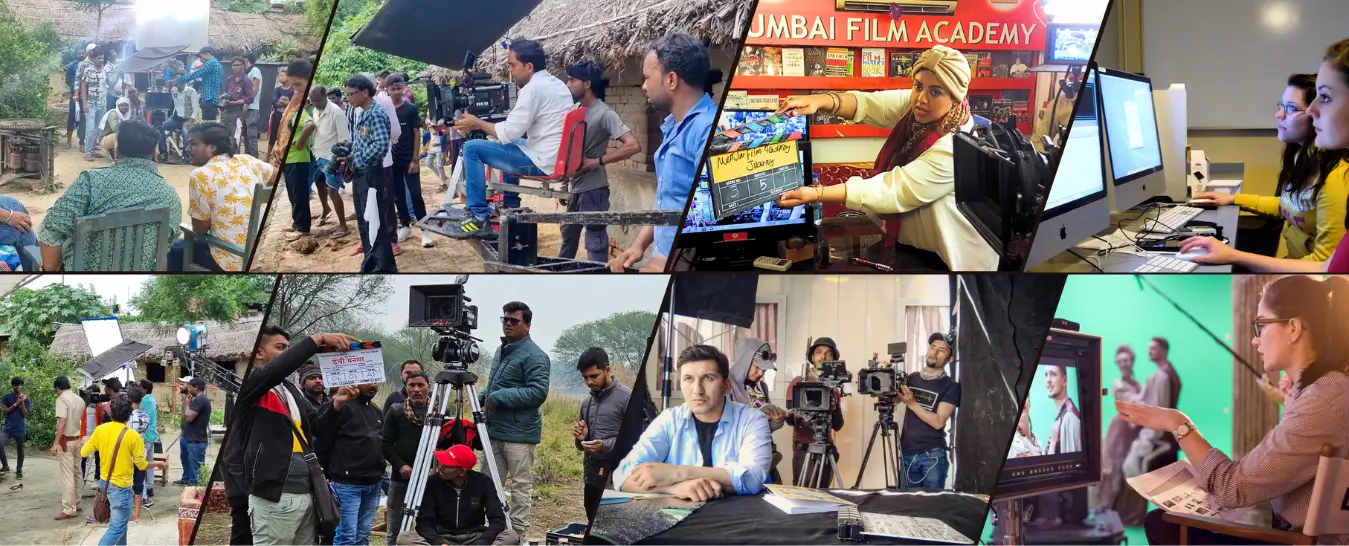Certification
We have Certificate and Diploma Courses in Film Making & Direction for 6/12 months with 100% Placement Assistance & Internship Option. Our courses are Flexible & Customized on regular Weekdays & weekends, and Full-Time / Part-Time Batches are available. We have a Rolling Admission Policy for the benefit of students. Admissions for current batches have started from 07th April 2025. Live Classes & Practicals will begin from 07th July 2025. Hurry Up Limited Seats, registration will be on a first-come, first-served basis, with 24 Students in One Batch Only. (18 Seats are Available for National Students & 6 Seats for International Students Only) Confirm your seat before 25th June 2025.
Course Featured
- 3 Hours Theory Classes
- Practical Classes 8 Hours
- 5/6 Sessions a Week
- Film Screening
- Film Shooting
- Film Appreciation
- Hands-on Practical
- Visiting Film Location
- 300 Class Rooms Sessions - 1200 Hours Classes - Divided into 500 Hours Theory & Screening with 700 Hours Practical Classes & Film shooting.
- During the Course Student will have to make 10-12 Films ie One Shot Film, Three Shot Film, 7 Shot Film, 2 Ad- Film, 3 Short Films ( Duration 2- 5 Min), 1 Music Video, 1 Documentary Film ( Duration 2-10 Min) & 1 Diploma Film ( Duration 2-10 Min)
- Diploma Completion Certificate
- 100% Job Placement Assistance
Enquire Now
Register Online For 2025 - 26
Course Content
- Evolution Of Cinema
- Golden Age Of Indian Cinema To Modern Cinema
- Realism And Neorealism In Cinema
- Basic Structure Of Script Writing
- Ideation
- Imagination
- One Liner Script Or Synopsis
- Fiction
- Non-Fiction
- Research & Story Development
- Presentation
- Story Narration
- Characterization
- Action, Comedy, Romance, Drama & Emotions for Full Masala Films
- Sitcom
- Comedy Drama
- Romantic Comedy
- Crime
- Adventure
- Sci-Fiction
- Fantasy
- Historical
- Horror
- Satire
- Social
- Thriller
- Biopics
- Drama With Emotions For Parallel Films
- Script For Television
- Script For Documentaries
- Script For Youtube
- Script For Webseries
- Script For Netflix, Prime Videos, Zee 5, Alt Balaji, Hotstar etc.
- Screenplay For Films
- Shooting Script
- Story Board
- Censor’s Script
- Story Rights
- How To Protect An Idea Or Script
- Contracts And Agreements
- Copy Right Infringements
- FILM MAKING & DIRECTION
First Viewer
Captain of the Ship
Handling Team
How picture moves
Principals of camera
- Making a Film Project
Preparing a Script
Idea (concept),
Plot,
Story,
Screenplay,
Dialogues,
Timing a script
Preparing Budget
Showing Business possibilities
- Production.
Entire process of Film Making
Film on Negative vs Video
Difference of Medium: Optical / Analog / Digital
Pre-production
Production
Post-production
- Script & Screenplay
Idea,
plot,
story,
screenplay,
dialogues
Premise,
characterization,
cause and effect,
Script Supervisor
handling a writer
- Visual sense
Frame and framing composition Rule of thirds
Negative and positive space
Types of Shots & Angles
Types of Camera Movements
Understand Lighting
Handling a Cameraman
Working with DOP / Cinematographers
- Preproduction for Director
Charts
Scheduling
Shooting Script
Shot division methods
Master shot / Insert … one by one
Indoor/ Outdoor
Day / Night
Story-board
Recee sense
Audition & Casting of Actors
Selection of Actors
- Production
Shooting
Where to put camera
Power of a shot
Rules of shooting 180 degree rule of Imaginary line
Handling Actors
Handling Teams
Handling Crews
- Assistant Directors
Job Responsibilities of Associate Directors
Job responsibilities of Clapper Boy
Job responsibilities of Costume AD
Job responsibilities of Pro Ad
Job responsibilities of 2nd Ad
Job responsibilities of 1st Ad
- Post – production
Editing sense
Power of a cut
Timing
Pace
Rhythm
Handling Editor
DI
VFX
- Sound
Importance of Sound
Types of sounds
Sync and non-sync sound
Dubbing or ADR & sync-sound
Use of silence
Impact of RR
Background Score
- Music Director
Working with Music Director
On Composition
Lyrics
Singers
Recordist
- Types
Film genre, forms, styles
Documentary Making
Music Video Albums
Web series
Episodes
Ad-Film Making
Corporate Film Making
Tele Shopping Direction
- Film Censor
Films are certified under 4 categories.
U (Unrestricted Public Exhibition)
U/A (Parental Guidance for children below the age of 12 years)
A (Restricted to adults)
S (Restricted to any special class of persons)
- Film Festivals
Making Short Films
Submitting Film
Screening Worldwide
National & International Film Festivals
Awards & Rewards
Pitching Producers & Financers
- Film & TV Direction
First Viewer
Captain of the Ship
Handling Team
How picture moves
Principals of camera
- Making a Film Project
Preparing a Script
Idea (concept),
Plot,
Story,
Screenplay,
Dialogues,
Timing a script
Preparing Budget
Showing Business possibilities
- Production.
Entire process of Film Making
Film on Negative vs Video
Difference of Medium: Optical / Analog / Digital
Pre-production
Production
Post-production
- Script & Screenplay
Idea,
plot,
story,
screenplay,
dialogues
Premise,
characterization,
cause and effect,
Script Supervisor
handling a writer
- Visual sense
Frame and framing composition Rule of thirds
Negative and positive space
Types of Shots & Angles
Types of Camera Movements
Understand Lighting
Handling a Cameraman
Working with DOP / Cinematographers
- Preproduction for Director
Charts
Scheduling
Shooting Script
Shot division methods
Master shot / Insert … one by one
Indoor/ Outdoor
Day / Night
Story-board
Recee sense
Audition & Casting of Actors
Selection of Actors
- Production
Shooting
Where to put camera
Power of a shot
Rules of shooting 180 degree rule of Imaginary line
Handling Actors
Handling Teams
Handling Crews
- Assistant Directors
Job Responsibilities of Associate Directors
Job responsibilities of Clapper Boy
Job responsibilities of Costume AD
Job responsibilities of Pro Ad
Job responsibilities of 2nd Ad
Job responsibilities of 1st Ad
- Post – production
Editing sense
Power of a cut
Timing
Pace
Rhythm
Handling Editor
DI
VFX
- Sound
Importance of Sound
Types of sounds
Sync and non-sync sound
Dubbing or ADR & sync-sound
Use of silence
Impact of RR
Background Score
- Music Director
Working with Music Director
On Composition
Lyrics
Singers
Recordist
- Types
Film genre, forms, styles
Documentary Making
Music Video Albums
Web series
Episodes
Ad-Film Making
Corporate Film Making
Tele Shopping Direction
- Film Censor
Films are certified under 4 categories.
U (Unrestricted Public Exhibition)
U/A (Parental Guidance for children below the age of 12 years)
A (Restricted to adults)
S (Restricted to any special class of persons)
- Film Festivals
Making Short Films
Submitting Film
Screening Worldwide
National & International Film Festivals
Awards & Rewards
Pitching Producers & Financers
- Different types of Cameras
- Video Camera
- Introduction to Video Camera
- Different Parts in the Camera and its Function
- Different Types of Cameras used in Videography
- Camera Angle
- Composition, Cutting, Continuity, Close-ups
- Light and Color
- Photographic Lights
- The Art of Lighting
- Basic Lighting
- Intro to Video Camera & Different Functions incorporated in it
- Studio lighting techniques
- Filters: Introduction, Its Effects
- Different types of Filters used for Creativity
- Exposure: Introduction
- Factors affecting Exposure
- Importance of correct Exposure
- Exposure Meter and its uses
- Wave front Vector Monitor
- Introduction to Lenses
- Basic Type of Primary Lenses
- Zoom Lenses, Micro Lenses, Close-ups diopters
- Depth of Field
- Perspective: Its Concept
- Types of Perspective
- Factors governing the Perspective
- Concept for Motion Picture
- Vision of Persistence
- The Cinematographer and His Job
- The Five C’s of Cinematography
- Outdoor Field Lighting
- Its contribution and its Roll in Cinematography
- Lighting Ratio and Lighting Contrast
- Raw Stock - Film:
- Different types of Ingredients used in Motion Film and its Purpose
- Several formats of films used in Motion Picture Industry
- Important Terminologies related to Raw Stock
- Types of Camera Movement- Horizontal, Vertical, Crane, Jimmy Zib, Trolley, Dolly and Steady-Cam
- Motion Picture Camera:
- Parts of the Camera body and its Function
- Color and Its Perception
- Nature of Light
- Composition of White Light, Additive and Subtractive Process
- Measurement of Color and its Application in Color Photography
- Different type of lights used in Cinematography
- Different type of Lighting Accessories and its uses
- Introduction to Editing
- Theory of Editing
- Linear & Non linear tools
- Script Analysis by an Editor
- Editing Terminology
- Styles of Cutting
- Rules of Non linear Editing
- Continuity
- Parameters
- Visualization
- Editing Sound
- Music Editing
- Multitrack Editing
- Cutting on Beat off Beat
- Basic Visual FX
- Editing News
- Final Cut Studio
- Avid
Distributor
A person who distributes the film through the theaters is called film distributor. The distributor buys the distribution rights from the producer, mostly in the intensely start itself (or) sometimes after previewing the colossal clip(trailers). However, the pre-acquiring of film distribution right is based very approximately on the casting, crew, director, credit, story and the producer’s old work. Also, Now days it is a okay tendency in film distribution in India that the producers itself, distributing the films without a third party (or) an independent film producer. They were implementing this method is because of avoiding the distributor expenses. On the basis of entertainment tax and come clean-to-confess connectivity, Film Distribution Association of India divided the state provinces into 11 circuits for distributing the filmss. Sometimes the distributors directly distribute films to every one of portion of these Circuits, even though new era the main distributor rent (or) sell films to a local film distributor.
Exhibitor
According To Film Glossary, a person who owned theater is called an Exhibitor. There are two ways an exhibitor, getting right to display a film in their theater. The first method is, going in checking account to the order of for the basis of a pre-appointment considering a distributor hire theater to showcase their films. The Second method is, the releasing centers (A Class Theaters) pay money(theater facilitate) to distributors for getting the right to display that particular film in their theater . Above, the Secondly explained method of Film Releasing is dependable on the subject of the basis of cast and crew; sometimes it is based upon the tie-happening along as well as Film Distributor and Exhibitor. Distributors glamor off the compensation (get the return) from the theater and it is known as Distribution Right. The Distribution right is calculated upon the basis of an concurrence taking into account the theater owner/Exhibitor Association and film distributor.
Sound: Importance
Types of sounds
Sync and non-sync sound
Dubbing or ADR & sync-sound
Use of silence
Impact of RR
5.1, 7.1, Dolby Atmos
A Person who Invest for making the Films is called Producer. They invest in films below a Production House brand make known: For an instance, the film producer Karan Johar owned Dharma Productions, he producing films under that Brand proclaim. A film Producer is answerable to run every single one, the expenses in film such as payment for the artists, technicians and managing the daily expenses.
Cost Of The Film: pre-production+ Film Production+Post Production+ Advertisement Expenses (Condition: 2% to 4% of trailer publicity expenses will be debited from Exhibitors)
Making Short Films
Submitting Film
Screening Worldwide
National & International Film Festivals
Awards & Rewards
Pitching Producers & Financers
Films are certified under 4 categories.
U (Unrestricted Public Exhibition)
U/A (Parental Guidance for children below the age of 12 years)
A (Restricted to adults)
S (Restricted to any special class of persons)
Career Opportunities
Students get Opportunity to work as a Film Maker, Film Director for Films, Tv Serieals, Webseries, Ads with Big Production House.























































































